Oyster stew is a classic Christmas Eve recipe, but it also serves as creamy comfort food that will get you through any cold evening. Fresh oysters are ideal for this soup, but canned oysters can work almost as well if fresh are not available. This soup/stew recipe is made with a base of bacon and vegetables, slow-cooked with dry sherry and oyster “liqueur” and then simmered with oysters, heavy whipping cream, and almond milk.

Jump to: RECIPE | Illustrated Step by Step | Tips for Success | Fresh vs Canned | Best Dairy to use | Freezing & Reheating
This post may contain affiliate links. As an Amazon Associate, I also earn from qualifying purchases. You can read our disclosure information here–
Ingredients
Ingredients for the stew (including one potato):
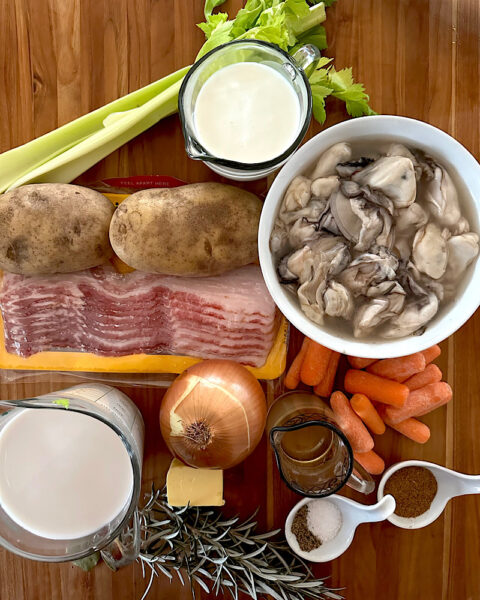
Illustrated Step by Step
Here are the steps lined out with photos. For the details of the recipe itself, see the recipe card below.
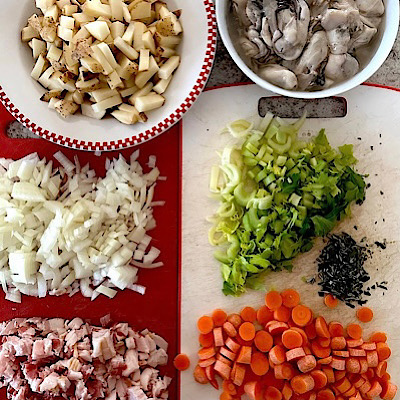
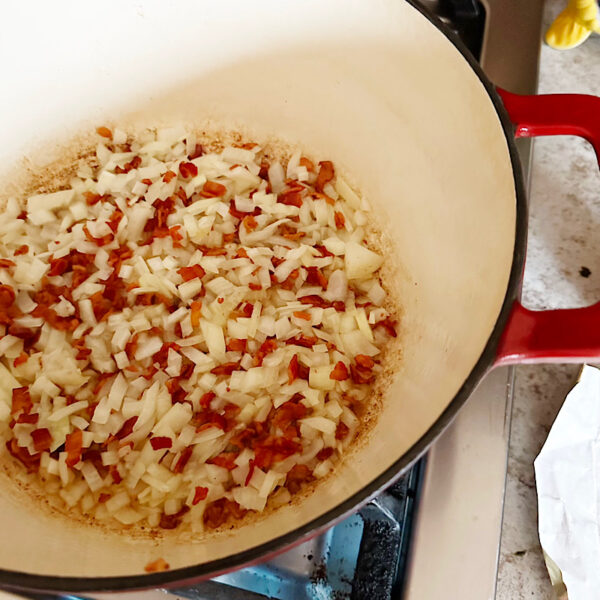
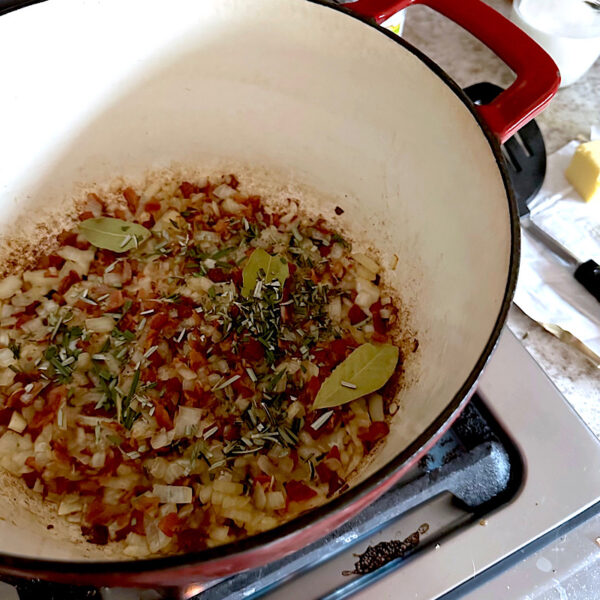
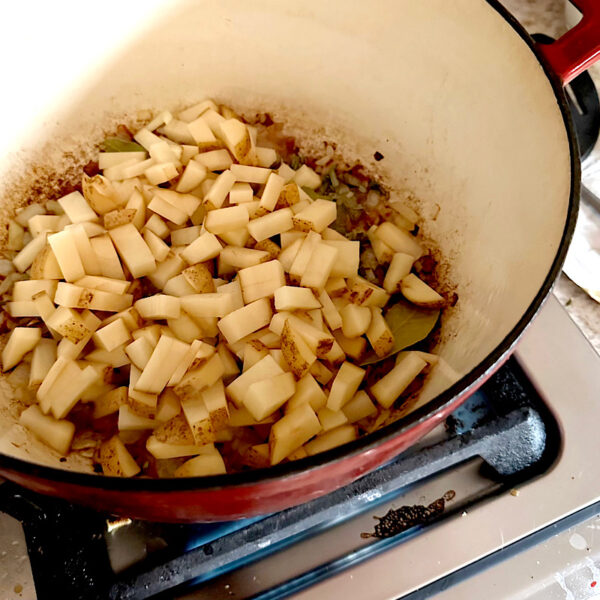
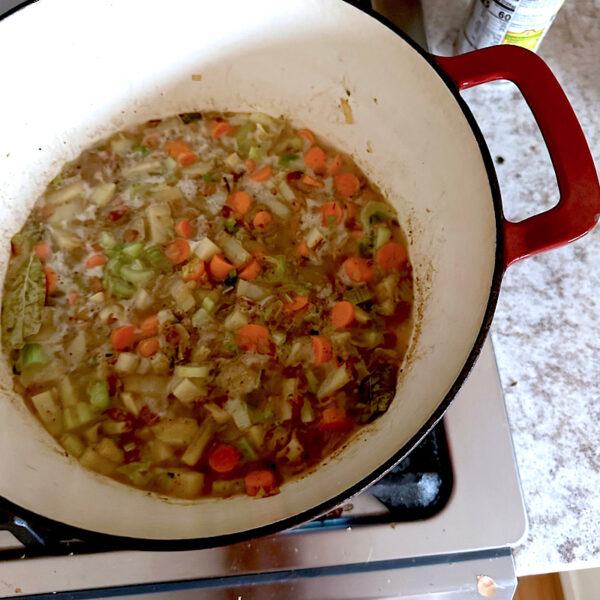
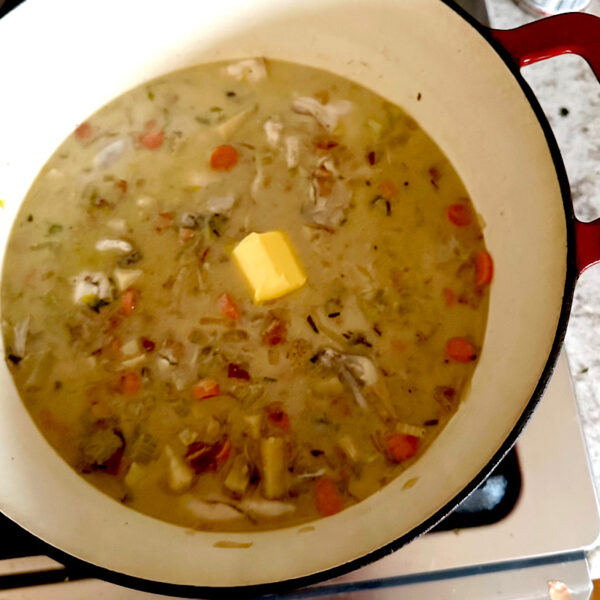
Tips to Perfect Oyster Stew
You can purchase oyster stew in a can from some grocers, but it isn’t very difficult to make from scratch, and it is 10x better.
Tip: The main thing is to not curdle the milk.
Here are some keys to making a perfect stew:
- Use fresh oysters if possible (see below on when and where to get them); if you can’t find fresh, canned oysters are a fine alternative. No smoked oysters though if you want to stick with the traditional creamy stew. Smoked oysters have a pretty strong flavor.
- You can also add one potato which will thicken the stew a bit. Even with the one potato, the stew is relatively low carb.
- Be sure and reserve the juice that you drain from the oysters. This is called the oyster “liqueur” and it adds a lot of flavor
- Oyster stew is typically mild in flavor. The herbs and spices you use are what will give it a lot of distinction. We used rosemary and Old Bay seasoning. Some people add some heat with a variety of chile spices and/or garlic.
- The most important thing is to take care not to curdle the dairy you use. We used heavy cream and almond milk and heated it over medium-low. Don’t leave the stove while the dairy is coming up to a simmer. You don’t want to let it boil as it will curdle and/or scorch the milk.
Fresh Oysters vs. Canned Oysters
Fresh oysters are “typically” best, but good ones can be difficult to find at certain times of the year.
There is a general rule that you should only buy oysters during the months that have an “R” in their name (January, February, March, April, September, October & November).
In Minnesota, where I live, I am only able to find fresh oysters in the grocery stores in November and December. I think that is due to the popularity of oyster stew on Christmas Eve. We never see them outside of these two months.
The rationale behind the “R” month rule is steeped in debate of course. All of the reasons I have read about make some sense, however.
Here are a few of the most often repeated reasons for this rule:
- The origin of the month with the letter R resulted from the lack of adequate refrigeration in earlier times and the cool/cold weather inherent in those months was seen as a safety factor for keeping the oysters from spoilage.
- During the warmer months, certain algae blooms – the dreaded red tide which carries a toxin that can be deadly to people. One reason often given is that the months that don’t have an R are the months that oysters breed and because they soak up red tide those months should be avoided. It should be noted that red tide is heavily monitored these days is not always present during the warm months.
- A reason given in the Chesapeake Bay area is that the summer months are for crabbing. The same watermen are responsible for both oysters and blue crabs. Although these days many of both are raised in “farms” year-round or harvested from southern states thus blurring the season.
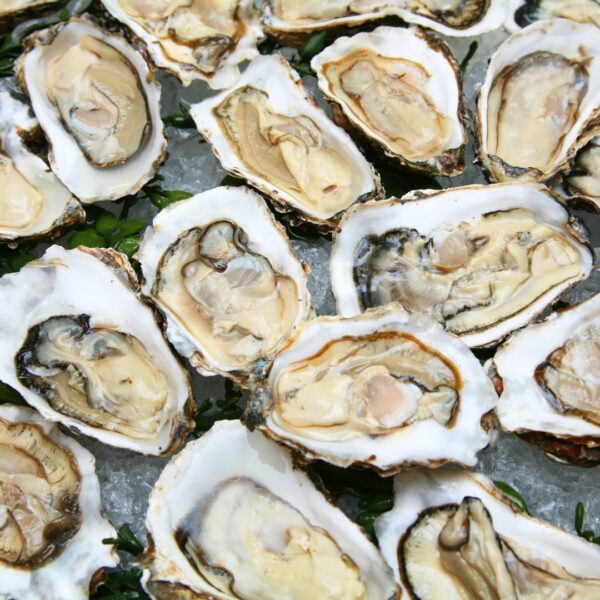
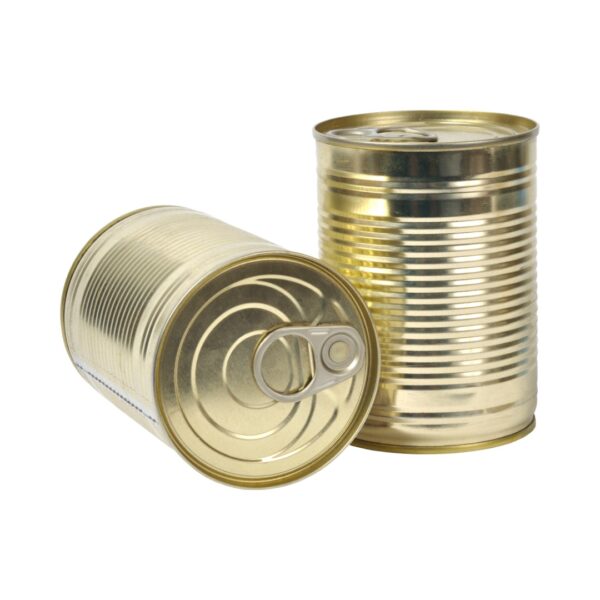
What kind of “Milk” is best to use?
Many types of cream or milk work in making oyster stew. Most of them are a matter of diet or taste preferences but the type of dairy you use may need some modifications to the recipe.
We used a mix of heavy cream and almond milk. Heavy cream gives the stew some body but 6 cups of heavy cream would make the stew richer and thicker than we like, so we used 2 cups of heavy cream and 4 cups of almond milk.
I have read recipes that use coconut milk, half and half, evaporated milk, 2% milk, and low-fat milk. The main thing to be aware of is that exclusively using a low fat dairy product will make for a thin soup.
If you want it thicker and are not on a low-carb diet, don’t boil it longer but rather add potatoes, cornstarch or a flour roux.
Tip: Boiling it longer to try and thicken may end up just curdling or scorching the milk you are using.
Speaking of curdling, make sure and cook the dairy over low heat. Enzymes in the oysters will make milk curdle faster if the temperature is too high.
How to Freeze and/or Reheat
Most soup recipes (including this one) are made in a large pot and there are often leftovers. Just make sure the leftover stew is kept refrigerated and then reheat slowly over medium-low heat and it’s even better the next day.
It should last 2-3 days if kept refrigerated.
I wouldn’t freeze oyster stew, as the milk products would separate.
If you find fresh oysters, however, shucked oysters can be frozen for up to 6 weeks.
I found some great oysters at Costco in November, but they were gone in a flash. Grab some when you find them fresh and at a good price so you can enjoy them after Christmas Eve is long gone but the weather is still cold.
Other Great Cold Weather Recipes
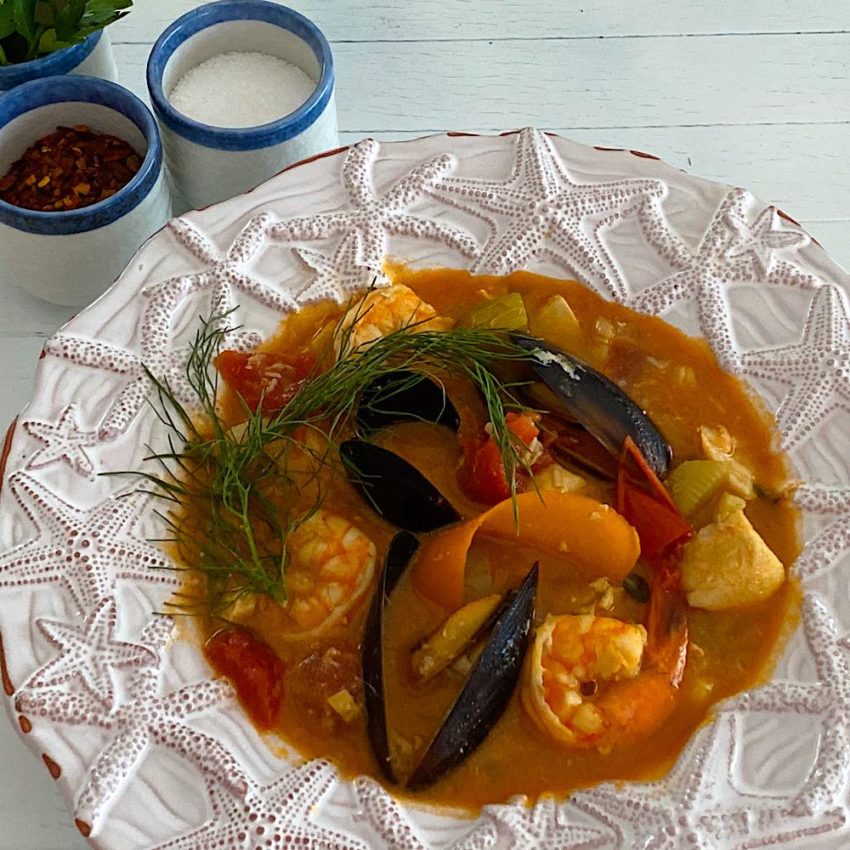
Here are a few of my favorite recipes for cold-weather cooking:
- Pork Posole in a Crockpot
- Pheasant Normandy Stew with Apples and Cream
- Moroccan Beef and Sweet Potato Stew
- Low Carb Bouillabaisse
- Low Carb French Bouillabaisse Stew
Like this recipe? It helps me out greatly if you leave a 5-star 🌟🌟🌟🌟🌟rating in the recipe card below and maybe even leave me a quick comment too!
Oyster Stew
Equipment
- Strainer
- large bowl
Ingredients
- 32 ounces whole oysters with juice Strained (you should get ~ 1 cup oyster liquid)
- ½ pound bacon diced
- 1 onion chopped
- 2 cloves minced garlic Optional
- 2 -3 sprigs fresh rosemary about 4” sprigs, needles removed from stem and minced
- 1-2 tablespoons Old Bay seasoning
- 3 bay leaves
- 1 large russet potato optional for a non-low-carb thicker stew. Scrubbed, and then chopped coarsely with skin on.
- 3-4 stalks celery Diced
- 6 ounces diced baby carrots about 2 cups
- ½ cup dry sherry extra dry (can use white wine if you don’t have sherry)
- ½ cup water
- 1 ½ cups heavy whipping cream Fluid cream
- 2 cups almond milk can substitute other “milks” here
- 1 teaspoon salt
- 1 teaspoon ground pepper
- 3-5 tablespoons butter
Instructions
- Use a strainer to drain the oyster juice (liqueur) into a bowl. Set the oyster liqueur aside, cover the remaining oysters and put them in the refrigerator while making the rest of the soup.32 ounces whole oysters with juice
- Dice the bacon and cook in a dutch oven (or large pot) over medium to medium high heat, stirring occasionally. (To dice, lay the pound of bacon on the cutting board and cut across the grain horizontally in 1/2” dice. If the bacon is partially frozen it is easier to dice.When bacon is crisp, drain the grease leaving 2-3 tablespoons in the pot or skillet.1/2 pound bacon
- Chop the onion and add it to the pot with the bacon. Cook over medium heat for about 5 minutes or until onions are soft and translucent. While onions are cooking chop the scrubbed potatoes, celery and carrots.1 onion
- After the onions are soft, add the garlic, rosemary, bay leaves and Old Bay and stir in for about 1 minute to blend together. Then add the potatoes, celery and carrots to the pot and stir everything together.2 cloves minced garlic, 2 -3 sprigs fresh rosemary, 1-2 tablespoons Old Bay seasoning, 3 bay leaves, 1 large russet potato, 3-4 stalks celery, 6 ounces diced baby carrots, 1 teaspoon ground pepper, 1 teaspoon salt
- Add sherry, water and reserved oyster liquid to the pot of vegetables and cook over medium to medium low heat for about 30 minutes1/2 cup dry sherry, 1/2 cup water
- Add oysters and almond milk to pot, stir and bring up to warm temperature. Then add the cream and ~ 3 tablespoons butter stir together gently and heat everything together over low heat.Watch the pot at this point so that the milk does not boil or curdle. It should take about 5 minutes to get it all heated through.1 1/2 cups heavy whipping cream, 2 cups almond milk, 3-5 tablespoons butter
- Serve with oyster crackers or some robust bread and enjoy!
Video
Notes
- TIPS FOR SUCCESS:
- Use fresh oysters if possible (see below on when and where to get them); if you can’t find fresh, canned oysters are a fine alternative. No smoked oysters though if you want to stick with the traditional creamy stew. Smoked oysters have a pretty strong flavor
-
- Be sure and reserve the juice that you drain from the oysters. This is called the oyster “liqueur” and it adds a lot of flavor
-
- Oyster stew is typically mild in flavor. The herbs and spices you use are what will give it a lot of distinction. We used rosemary, garlic and Old Bay seasoning. Some people add some heat with a variety of chile spices
-
- The most important thing is to take care not to curdle the dairy you use. We used heavy cream and almond milk and heated it over medium low. Don’t leave the stove while the dairy is coming up to a simmer. You don’t want to let it boil as it will curdle and/or scorch the milk.



Leave a comment